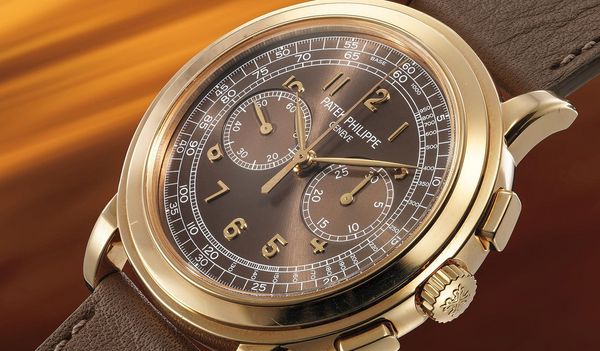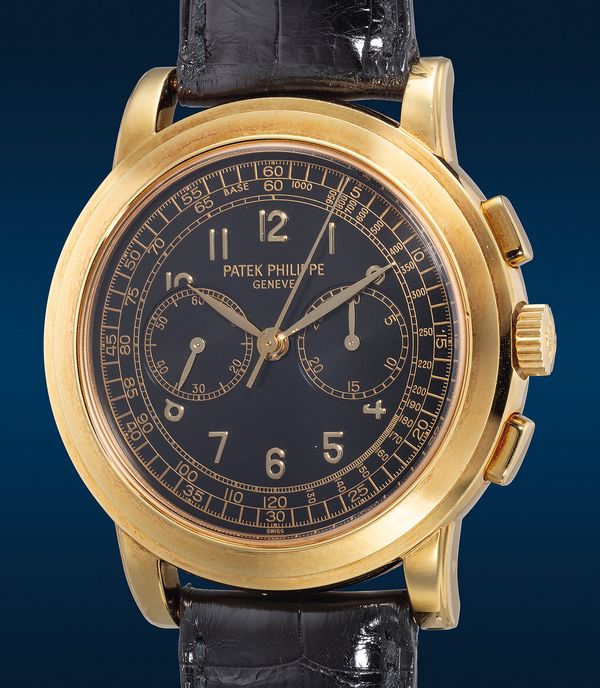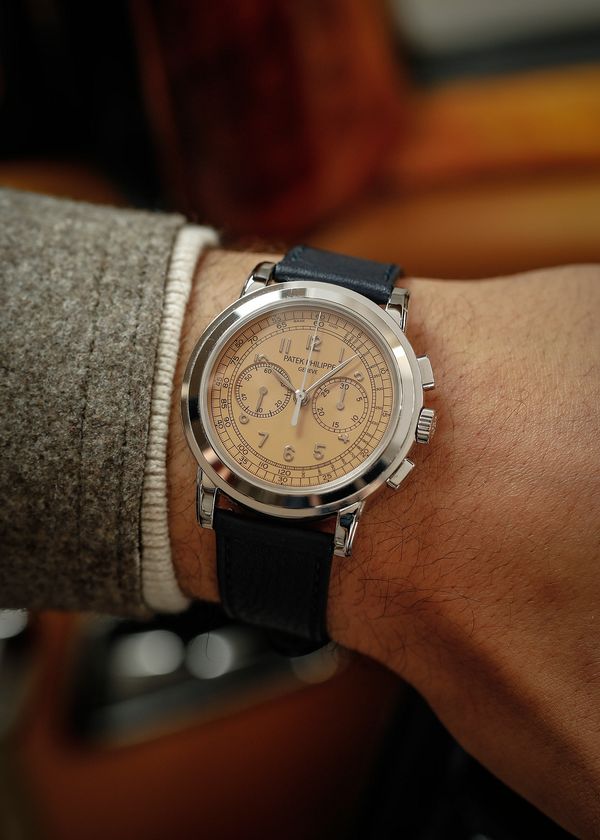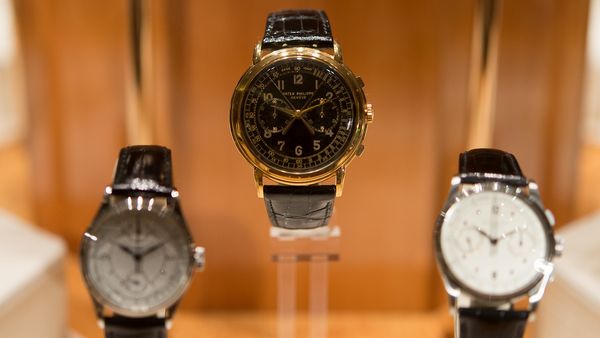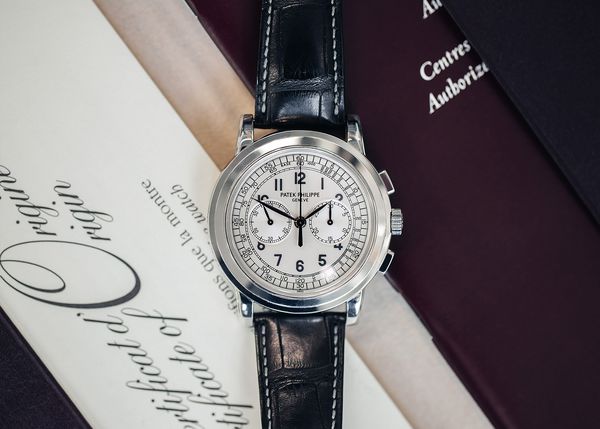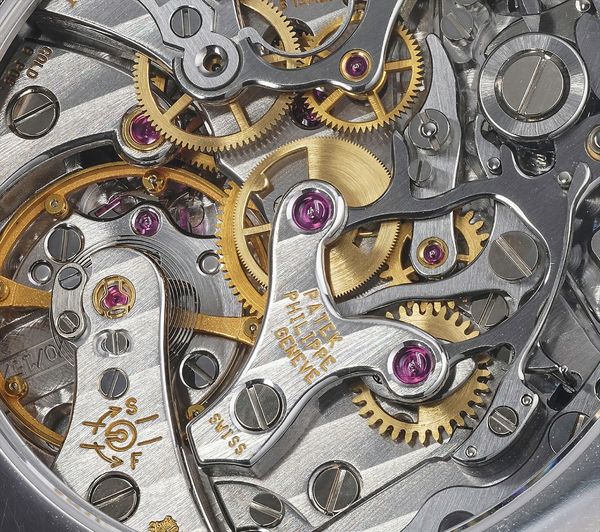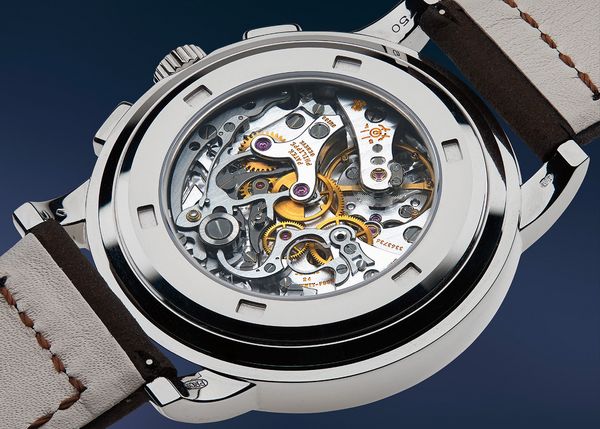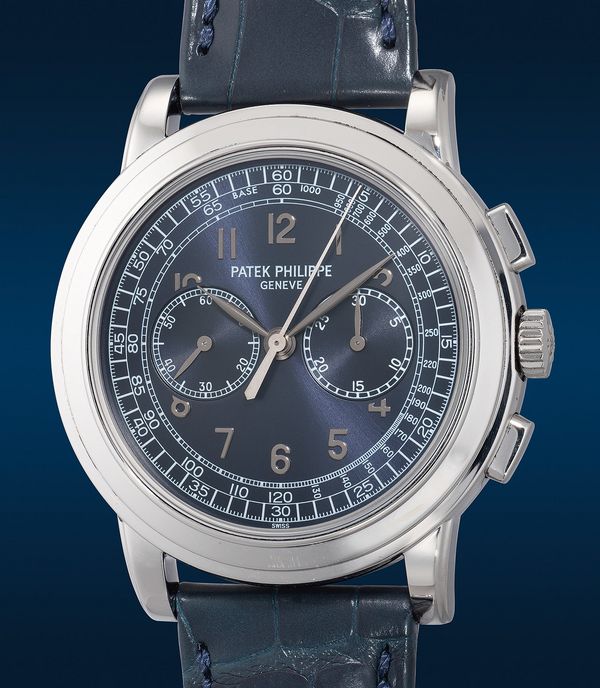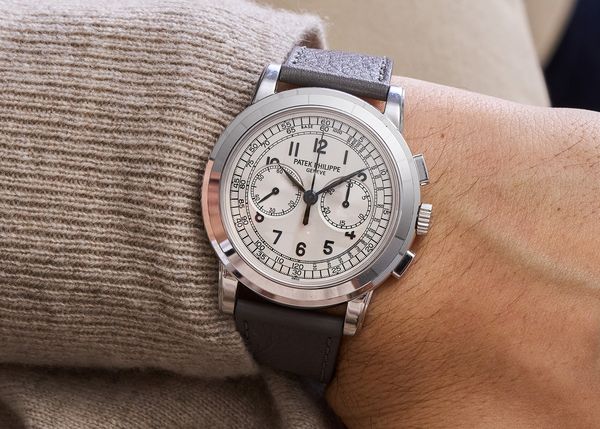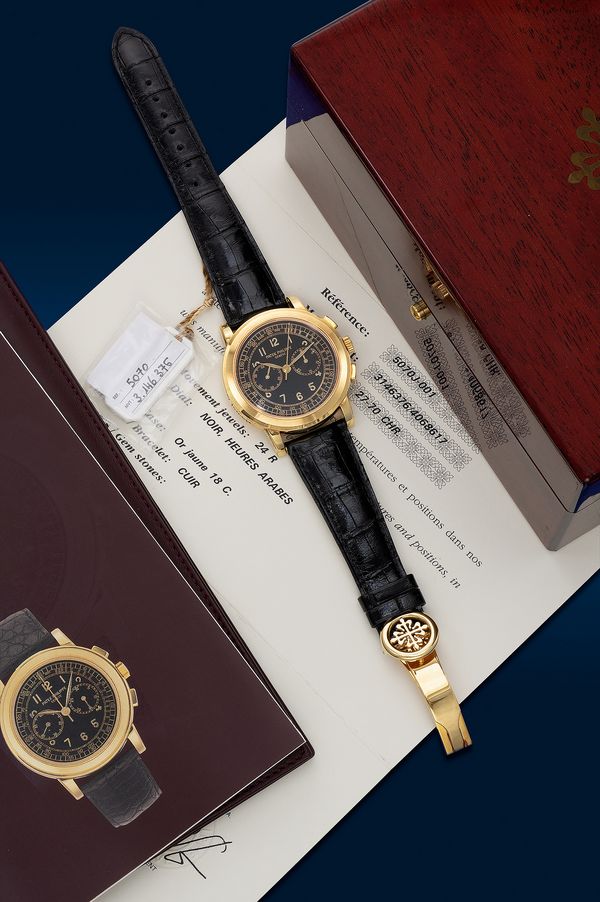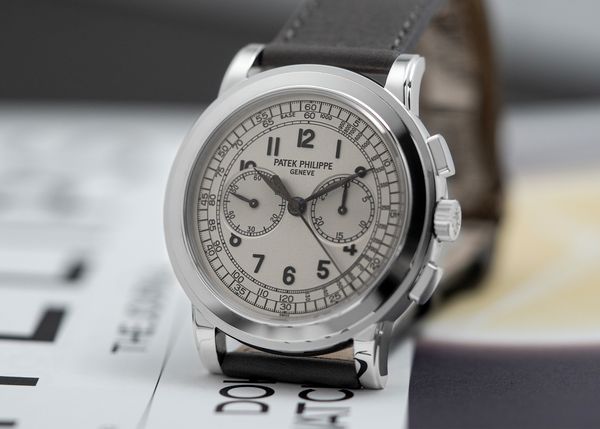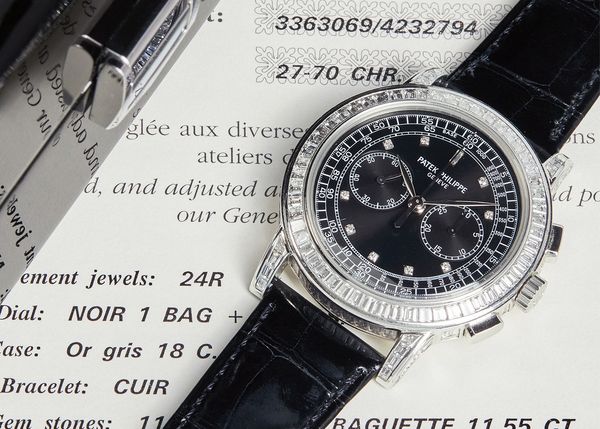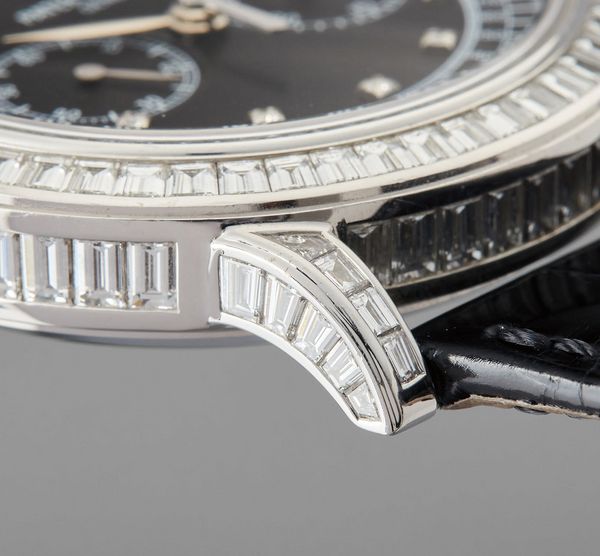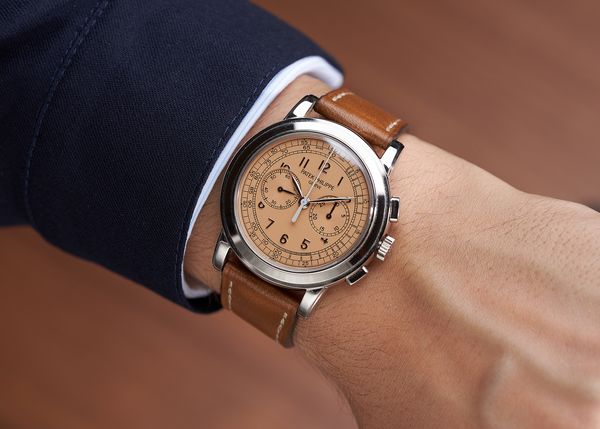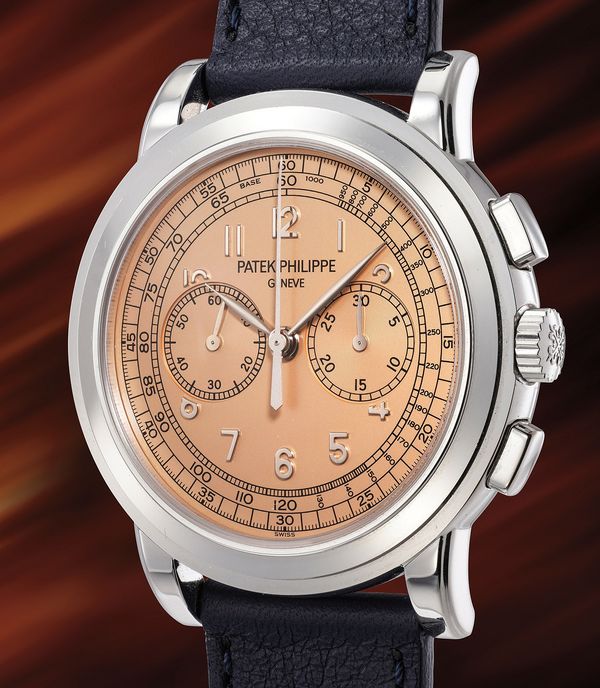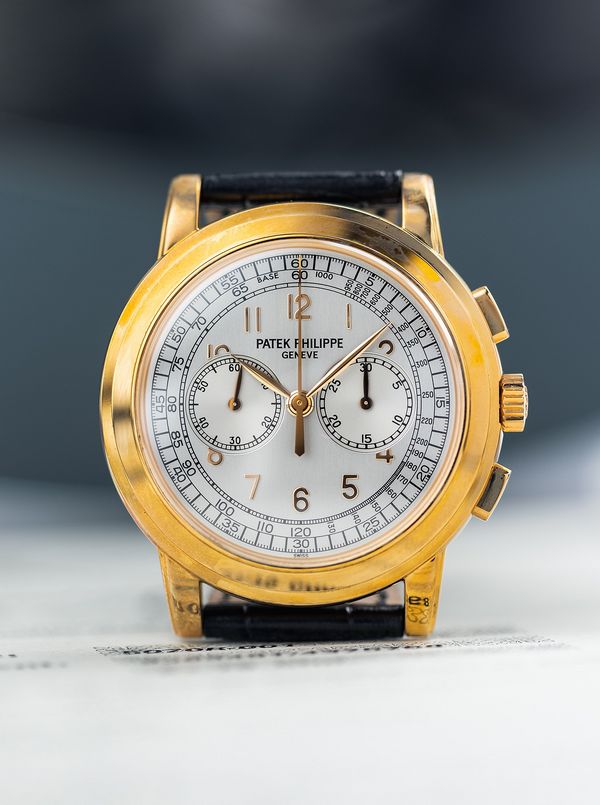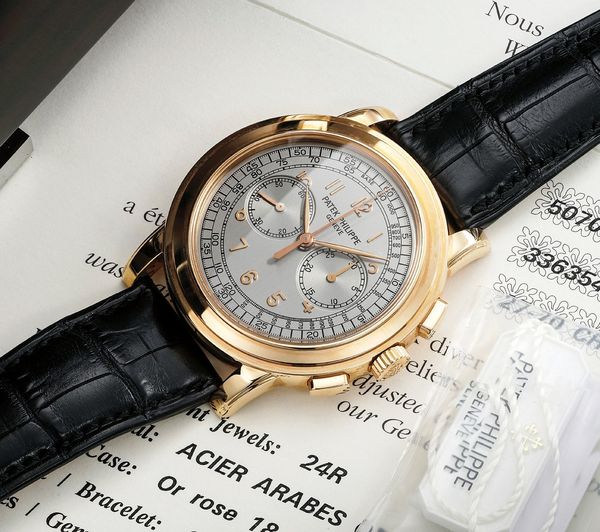Welcome to The Fine Print, our new column dedicated to deep dives and detailed guides on watch collecting. The first batch of watches to receive this in-depth treatment is the Patek Philippe ref. 5070, a relatively underrated gem of a modern chronograph that just-so-happens to celebrate its 25th anniversary in 2023.
– By Logan Baker
If you’re passionate about Patek Philippe, you'll be well aware that there are certain reference numbers that can fill any room when spoken out loud. You know the ones I’m talking about.
2499. 1518. 1463. Those digits have never sounded so sweet.
5970. 6300. 5711. The only integers I'm aware of that can make grown men swoon.
Those numbers represent some of the most desired timepieces in existence. They are sought-after for their historical importance, their beauty, and their mechanical ingenuity.
But what if I were to tell you that there’s a reference that fits many of the same criteria as those listed above, yet has – inexplicably – yet to have earned its place in the minds of collectors on the Mount Rushmore of modern classic Patek Philippes wristwatches.
The watch I’m talking about is the Patek Philippe Chronograph ref. 5070. It's a 42mm twin-register chronograph cased in precious metal that was first released at the Basel fair in 1998, and it's been sitting right underneath all our collective noses for exactly 25 years.
You might be thinking that my above description paints a fairly tepid picture of the ref. 5070, but it’s those exact details that bewildered the Patek collector community in 1998.
Maybe it’s a simple coincidence that the Patek Philippe ref. 5070 was released just two years before the start of the new millennium. But more than any other Patek of the era, the ref. 5070 is the best representative of this very brief transitional moment in time for the world-famous Swiss watchmaker.
The ref. 5070 pushed Patek forward, propelling the company's evolution as the 21st century reared its head, all while preserving the playbook that was behind many of Patek's greatest 20th-century success stories.
The Ref. 5070, The Dawn Of A New Era
There are three critical bullet points to understand why, exactly, the ref. 5070 is both a historically significant reference for Patek Philippe, as well as one that's generally underrated by collectors.
-
It was the first new chronograph released by Patek Philippe that was not equipped with an additional calendar function since the original ref. 1463 – yes, the legendary “Tasti Tondi” – was discontinued in the 1960s. The ref. 5070 has no hidden rattrapante or flyback mechanism, it’s as straightforward of a chronograph as you can find, with a central chronograph seconds hand and a 30-minute totalizer at three o’clock. Patek Phillipe went some 30 years without a simple chronograph in its catalog – hard to believe, right?
-
The ref. 5070’s 42mm case diameter made it the single largest wristwatch created by Patek Philippe since 1950, when the possibly unique, luminous-dial ref. 2512 split-seconds chronograph, listed at 45mm in diameter, was born (and which can now be found inside the official Patek Philippe Museum in Geneva). Although a 42mm diameter doesn’t sound enormous today, especially when considering the 5070’s slight 11.6mm case profile, the 5070 was easily one of the largest high-end chronographs on the market from any brand in the late 1990s, coming in at the same diameter as Audemars Piguet’s famously large Royal Oak Offshore.
-
It was the final Patek Philippe chronograph to utilize a Lemania ébauche, the manual-wind caliber 2310, rechristened as the caliber CH 27-70 inside the ref. 5070.
And yet, despite all these evolutionary changes, the ref. 5070 still looks as if it could have been taken straight out of a 1950s-era Patek Philippe catalog – and a part of it clearly was. The ref. 2512 that now resides in the Patek Museum influenced the ref. 5070 in more ways than just its extra-wide case diameter.
The stacked tachymeter scale and railroad-style track with one-fifth of a second gradations on the periphery of the dial is clearly shared between the two references, as are the perfectly centered and level twin sub-dials. The ref. 2512 has a hint of a stepped external bezel, which the bezel of the ref. 5070 clearly builds on with its sloping, polished multi-stepped design – an aesthetic choice that has become the reference’s signature feature. Every detail on the case, from the leaf-style handset to the rectangular chronograph pushers and the downturned, 2499-esque beveled lugs, echo classic mid-century watch-design ideals that prioritized information and legibility above all.
Interestingly, Patek Philippe was only able to acquire the ref. 2512 in 2000 (they paid a princely sum of CHF 1,439,750 to win the watch at auction). Given the ref. 5070 was already out in the world at that point, it can only mean that former Patek Philippe President Philippe Stern and his team of designers had likely been on the hunt for it for years.
William Massena, the former managing director of TimeZone, erstwhile auctioneer, and the current proprietor of the Massena LAB concept studio and watch brand, attended the 1998 Basel fair where Patek Philippe unveiled the ref. 5070 to the public for the first time.
“It was shocking because Patek was making small, little watches at the time,” he says. “The biggest watch from Patek back then was maybe 36mm or 37mm. There was nothing big. The 5004 was 37mm at the time; it had just come out, and it was a $200,000 watch. The 3970 was 36mm. All the Calatravas were small. The Aquanaut 5056 was small. Everything was super small. So here comes this huge watch – and it's their first chronograph in 30 years! Plus, it was affordable compared to the 3970 and 5004. It was legible, big, manual wind, and no date. The case was amazing with the stepped bezel. It was heaven.”
The combination of the caliber CH 27-70 with the 42mm case design is potentially a curious one. The CH 27-70 movement is, of course, based on the legendary Lemania 2310, which was first adapted as the CH 27-70 by Patek all the way back in 1986. It saw action inside three separate Patek Philippe Perpetual Calendar Chronograph generations (the ref. 3970, 5020 and 5970), the as well as the ref. 5004 Perpetual Calendar Split-Seconds Chronograph, starting in 1996. Patek Philippe even received a patent for its split-seconds approach inside the ref. 5004, thanks to the unique isolator system that helped eliminate rate deviations when the split seconds function was engaged.
The 24-jewel caliber CH 27-70 is a truly excellent chronograph movement, outfitted with a large mono-metallic Gyromax balance wheel, shock absorption, a straight-line lever escapement, a column wheel, a slower frequency of 2.5Hz, and an impressive running autonomy of 58 hours when completely wound. When the 5070 was released, Patek even stated that the individual teeth on the wheels of the going train had been adjusted for a “smoother transmission of energy in the movement and constant mechanical precision, with new ratios from the center wheel to the barrel contributing to the reliability and accuracy of the movement.”
Impressive, huh? All that said, it still wasn’t until the 5070 that the caliber CH 27-70 found a home in its simplest format.
One small issue with that, however, is that the caliber CH 27-70 has a diameter of only 27.50mm, which is visibly on the small side compared to the 42mm case housing it. However, if you look at the movement through the exhibition back, there doesn’t appear to be much extra room. How can that be?
Well, Patek designed the caseback using a multi-level, screw-in approach that is widest at the base and narrows as it transitions inward. So, when you look at the movement through the caseback, it appears to fill the entire case profile. It’s quite effective as a visual trick.
The small size of the movement is also the primary reason for the exceptionally centralized placement of the two chronograph registers on the dial. The completely annular design of the dial and case makes the position of the sub-dials less apparent, but if you do happen to have an aversion to the hour numerals of your watch being chopped in half by a sub-dial, the 5070 might not be the right watch for you.
The caliber CH 27-20 featured a far more intricate approach to decoration and finishing than what you’d have found in any of its relatives. Anglage is executed by hand, Cotes De Genève is clearly visible on the bridges and balance cock, and you can even easily spot the polished interior angles within the movement architecture.
There are so many small aesthetic details that stand out on the ref. 5070. It’s an excellent example of prioritizing thoughtfulness in design – no detail was spared in its execution. That’s one of the main reasons why the ref. 5070 was so successful in pushing the envelope at Patek Philippe – as it went simpler and bigger, it didn’t hesitate to embrace its heritage, signaling a critical separation away from the Royal Oak Offshore's famously transgressive attitude.
It wouldn't be much of a stretch to say that the comprehensive, cohesive, and – most importantly – successful execution of the 5070 gave Patek Philippe the confidence to enter the new millennium more open to experimentation. We’ve since seen Patek Philippe surpass the 5070's 42mm case diameter multiple times (hello, Grandmaster Chime). You can even see clear elements of the 5070 case profile on the cases used for the Minute Repeater ref. 5079, the Grand Complication ref. 5073, and the Grand Complication ref. 5074.
“Purely from an aesthetic perspective, I truly love everything about the 5070,” Jasem Al Zeraei, the Kuwait-based founder of Patekaholic on Instagram and a longtime 5070 supporter, says. “Yes, the size works well for me because of my large wrists, but besides that, the case design is just so beautiful and so elegant. It's still 1930s, '40s Patek Philippe but in a larger size. The dial is also perfectly set. If you look at the sub-dials, they’re literally in the perfect position at three and nine o'clock. And if you look around the world of watches, and especially at other chronographs, I don't think anyone has laid out a dial and sub-dials as perfectly. I'm in love with the 5070.”
What might surprise many collectors about the ref. 5070 is the total number of variations that were produced. Most watch lovers will be familiar with the core four case metal configurations that were produced mostly non-consecutively over approximately an 11-year period, but that’s just the start of the rabbit hole that is the 5070's back catalog.
The Watches
The Ref. 5070J: Yellow Gold, Black Dial
Approximate Production Run: 1998-2002
It's not unusual for Patek Philippe to issue the first version of any new serial reference in 18k yellow gold, before eventually expanding to other materials – and the 5070 was no different.
The 5070J is the watch that started it all. It was the only configuration revealed by Patek Philippe on that initial launch day in spring 1998. The 18k yellow-gold case is beautifully contrasted by a pitch-black dial with applied Arabic numerals and hands made of matching 18k yellow gold. All other markers on the dial are rendered in a sleek gilt printing that radiates sophistication.
As the inaugural example of the ref. 5070, the yellow-gold, black-dial color combination is what many collectors picture when the reference comes up in conversation. This exact dramatic configuration was chosen by Patek to lead things off – I assume – in order to make a bold statement. The ref. 5070J had to capture the attention of both Patek's clients and retailers, and although Patek didn't know it at the time, it was also the watch that would soon have to do battle against A. Lange & Söhne's Datograph, which would be revealed just one year after the 5070J’s debut, in 1999.
The original retail price for the 5070J was approximately CHF 30,000. After four years of limited production, Patek Philippe would officially pull the plug on the yellow-gold chronograph, with a pair of subtle successors waiting in the wings. Out of the four 5070 configurations that entered regular production, it's fair to say that the original ref. 5070J remains the most visually striking.
The Ref. 5070R: Pink Gold, Silver Dial
Approximate Production Run: 2003-2007
Patek Philippe followed the 5070J up with two different new case-metal options at once, including the ref. 5070R with an 18k pink-gold case and a silver-grey dial featuring matching pink-gold hands and applied Arabic numerals for the hours.
All of the printing on the dial for the scales and registers is executed in black, allowing for optimal legibility against the off-white dial tone. We know of at least one instance of a 5070R with a Tiffany & Co.-signed dial appearing on the secondary market.
The ref. 5070R was in production for approximately four consecutive years before it was ultimately retired in 2007.
The Ref. 5070G: White Gold, Silver Dial
Approximate Production Run: 2003-2007
Introduced (and discontinued) on approximately the same dates as the 5070R, the 5070G is the 18k white gold variation of the chronograph. The color of the dial is very similar to the 5070R, but the 5070G is the only model in the series to have dark-colored applied Arabic numerals representing the hours.
The hands, meanwhile, are constructed out of 18k white gold, matching the case metal, but they’ve received a special surface treatment to reach a darker shade for enhanced legibility. There have been numerous instances of a 5070G with a Tiffany & Co.-signed dial appearing on the secondary market.
With the tone-on-tone combination of the white gold case and silver dial, the 5070G is the subtlest option in the 5070 range, almost passing for stainless steel at a glance. Just like the 5070R, the 5070G was discontinued in 2007 after approximately four years of production.
The Ref. 5070P: Platinum, Blue Dial
Approximate Production Run: 2008-2009
A full decade after the 5070’s debut, Patek Philippe followed it with a swan song in the form of a platinum-cased 5070 with a metallic blue dial. Of course, as a modern Patek Philippe wristwatch made of platinum, a hidden diamond is set inside the caseband near the six o’clock position.
In production for approximately one year, the 5070P included hands and applied Arabic numerals made of 18k white gold. The printing on the sunburst blue dial is a clean, crisp shade of white. The 5070P had an MSRP of USD $87,500 when it was first released.
The use of a blue metallic dial gives the 5070P the most contemporary appearance out of the entire 5070 series. And given its short production run, it’s also the rarest and most desirable of the four core 5070 models. Additionally, there have been numerous instances of a 5070P with a Tiffany & Co.-signed dial appearing on the secondary market.
The Ref. 5071G: White Gold, Baguette-Bezel
In addition to the standard production examples of the 5070J, –R, –G, and –P, there have been numerous unique pieces and small-batch models produced over the past 25 years. The white-gold ref. 5071G with a baguette diamond-set case, for instance, was only produced on special request for Patek Philippe's most important clients.
It was apparently incredibly time consuming to source such well-matched diamonds, and setting the baguette stones was said to be extremely labor-intensive. Not only is the bezel diamond-set, so are the sides of the case, including in between and on top of the lugs. Even the deployant buckle is set with beautiful baguette-cut diamonds. All together, the diamonds weigh approximately 11.55 carats.
The dial is further set with nine brilliant diamonds set in chatons, which gleam against the black background. As a result of the difficult setting process, very few examples of the 5071G were manufactured, and the reference is extremely rare. In fact, according to research, only four examples have appeared on the auction market to date, out of eight total known examples.
Social media was recently set ablaze when it was revealed that the legendary hip-hop artist and entrepreneur Jay-Z had acquired one of the eight examples. Jay-Z was seen wearing the watch on June 27, 2023, while performing at the Louis Vuitton 2024 Men’s Fashion Show, during Paris Fashion Week.
The White Gold, Salmon Dial 5070G (Pre-Vintage Collection)
Another evolution of the white-gold 5070, this extremely rare example with a salmon-tone dial appeared at a Phillips Geneva auction in November 2022, where it sold for CHF 852,800, setting an auction record for the 5070 family.
The Platinum, Black Dial 5070/1P-010 Unique Piece On Bracelet
A variant of the 5070P produced in 2012 at the “request of an important client,” the ref. 5070/1P-010 exchanges the 5070P's recognizable metallic blue dial with a black one, pairing it with a matching platinum “brick” bracelet. It has appeared publicly once before, at a Hong Kong auction house in 2021.
The Four 5070s Of The Vintage Collection, Released In 2015 (!) At The Saatchi Gallery In London
To commemorate the 2015 Patek Philippe Grand Exhibition at the Saatchi Gallery in London, Patek Philippe produced a range of special watches in highly limited runs. Surprisingly, this included four new versions of the ref. 5070, five years after the reference was "officially" discontinued and replaced by the next-gen ref. 5170 chronograph. Patek Philippe communicated that this choice was the result of a surplus of unused cases from the reference's production years, as well as the discovery of a set of new-old-stock Lemania calibers.
Each of these four references is believed to have been limited to five examples each. The different models included a platinum version with a blue dial that's a touch lighter than the production 5070P (ref. 5070P-013), an 18k yellow gold version with a sunburst brown dial (ref. 5070J-012), a white-gold version with a salmon dial (ref. 5070G-014), and a rose gold version with a sunburst brown dial (ref. 5070R-014).
The dials of all four of these so-called "Vintage Collection" 5070 examples were also slightly tweaked compared to the original models, including an updated font for the “Patek Philippe Geneve” logo, slimmer numerals on the running seconds display, and adjusted designs for all uses of “1”, “7”, and “4” on the dial. These watches were never officially publicized or exhibited by Patek Philippe, and images are hard to come by, but luckily you can view a few excellent photos of the ref. 5070J-013 in this article by our friends at Quill & Pad.
Interestingly enough, similar to the 5071G mentioned above, Jay-Z was also recently spotted wearing a salmon-dial 5070G in late May 2023 while attending the Paris concert of his wife Beyonce's Renaissance World Tour. It's not known whether Jay-Z's salmon-dial 5070G is one of the few Saatchi Gallery examples, or if he was able to acquire one of the even rarer pre-Saatchi versions with papers dated to 2014.
One-Of-A-Kind 5070(s)
A well-know media executive and prodigious Patek Philippe collector known as "MSO" is confirmed to have custom ordered at least one unique 5070 example from Patek, featuring his initials at six o’clock on the tachymeter scale. The case of this example is made of 18k yellow gold and the dial is a lovely sunburst shade of brown, but what makes it particularly special is the absence of the traditional Arabic hour numerals save for 12 o’clock, which is executed in the classic Breguet style. The hands have also been swapped for a Dauphine format, and luminescent material is present inside the hands as well as on the dial.
Many collectors believe that MSO commissioned more unique 5070 examples from Patek, potentially up to three additional one-of-a-kind 5070s. The potential dial/case combinations that I’ve heard floated include a rose gold case with a brown dial, a white gold case with a salmon dial, a yellow-gold case with a black dial, or a platinum case with a light blue dial. It's likely that any further unique 5070 examples commissioned by MSO will come with the same combination of his signature at six o’clock, the Dauphine handset, and the individual Breguet numeral at 12 o’clock.
Unconfirmed 5070 Rumors
There are a number of reports regarding unique (or potentially unique) 5070s that are out in the world and have yet to surface.
One of the most prominent ones is the legend of a unique 5070 with a stainless-steel case and bracelet, a black dial, and dagger hands. It’s been wishfully discussed in public a handful of times by Zeraei (@patekaholic), but there is no confirmation it exists – yet.
Many individuals in the Patek collecting scene also believe there may have been a total of three salmon-dial 5070s created, (including the potential MSO example). Some believe there is a largely identical version of his watch out there that comes with the original leaf hands and no signature.
Collecting The Ref. 5070
If we turn our focus back to the four primary 5070 configurations in yellow gold (–J), rose gold (–R), white gold (–G), and platinum (–P), we can attempt to confirm a few details about the reference's overall production history.
Patek Philippe published in an early 2000s edition of the company’s official magazine that production of the 5070 would remain limited to no more than 250 pieces per reference per year. If Patek stayed true to that total throughout the entire lifespan of the 5070, that would mean approximately 1,000 examples were created of each of the yellow-gold 5070J, the pink-gold 5070R, and the white-gold 5070G.
The production timeline of the platinum 5070P is believed to have been approximately one year – maybe a little more, maybe a little less – resulting in a ballpark of 250 pieces. Generally speaking, I think it's always appropriate to estimate that the actual total production number of any unconfirmed reference is slightly below the potential "maximum" amount.
The 5070 is a relatively rare watch. It was never mass produced, and I guarantee there are far fewer 5070 examples out there than there are 5711s or 5960s. However, despite its overall rarity, the 5070 has also never been an overly difficult watch to source. A few examples will typically be put up for sale every auction season (more on that below), and they'll even pop up on major secondary market online platforms on a semi-regular basis.
“Let’s say there’s a few thousand watches total between all the reference numbers,” Zeraei says. “It's not a huge number, but it’s not a great number, either. You’d need five million people who are interested in these watches for them to move continents in terms of price.”
There are a few reasons the 5070 has never maintained significant collector cache. Depending on who you ask, one reason that’s long been whispered about is the fact that the reborn A. Lange & Söhne introduced the Datograph – one of the first true in-house chronograph movements produced by anyone in decades – in 1999, one year after the 5070's debut.
“The Datograph completely blew everything out of the water,” Massena says. “It was brand new. It was very highly finished. The movement fit the case. It was smaller. It had a flyback mechanism. There were a lot of things going on with the Datograph that the 5070 could not compete with. Collectors also started to realize that watch brands could actually make a chronograph if they wanted to, so I believe it pushed Patek to start developing their own movement."
Whatever the reason was, the original 5070J – despite its historical significance, its eye-catching configuration, and its overall high quality level – never seemed to find its footing among collectors in the late ‘90s and early 2000s. Massena even mentioned in my conversation with him that he was able to purchase his personal 5070J (which he still owns today) from an Authorized Retailer for below its list price around 2000.
The 5070R and 5070G appear to have been a bit more successful in generating collector interest during their production years compared to the 5070J, with the earliest recorded auction data showing results over MSRP for both references.
The 5070R and 5070G walked so that the 5070P could run. The platinum model was an immediate hit, with numerous online reports at the time mentioning it would be an exclusive application-only piece, intended to only reach Patek’s most loyal clients. It’s no surprise, then, that the 5070P remains to this day the rarest and most expensive to acquire of the four main 5070 configurations.
Since its discontinuation, the 5070 family has largely been ignored within general collector discourse. It's never been a "sexy" watch to collect, despite the unique evolutionary role it played in Patek Philippe's modern history.
"It's amazing how underrated the ref. 5070 is now,” Massena says. “There's no interest whatsoever in it; I really think nobody cares about it. It's kind of sad, but I don’t know if people want a 42mm watch anymore. There are so many more chronographs from Patek now. The 5070 was doing well, but then the ref. 5960 came out in 2006. It had a new in-house chronograph movement with an annual calendar and it was more wearable than the 5070. So people moved in that direction. And then the ref. 5170 came out, which was also a more wearable watch for most collectors.”
The Ref. 5070 In The Auction Room
One of the most interesting parts of putting this inaugural edition of "The Fine Print" together was being able to delve into the past 20-plus years of auction results for the 5070. What I realized after studying the data surprised me.
In its three primary gold configurations, the 5070 family has remained remarkably consistent with its auction performance over the past two decades. There are really no extraordinary peaks and valleys in the data at all; there are zero significant surges, declines, or outliers of interest to highlight.
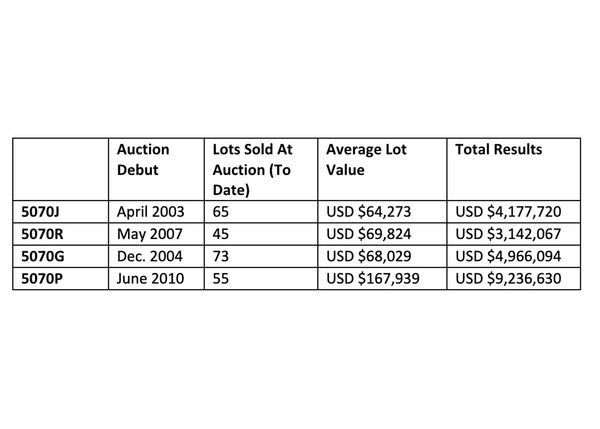
It’s extremely unusual, especially in an era of watch collecting often characterized by dramatic swings in value for flagship watches such as the Patek Philippe Nautilus 5711, the Audemars Piguet Royal Oak 15202, and the Rolex Daytona 116500, each of which has seen a decline in secondary market valuation in the 40 percent range over the past 18 months.
The 5070’s consistency is almost shocking compared to the trends that follow many of today’s so-called "hype" watches.
Just take a look at some of the data I’ve pulled above and below.
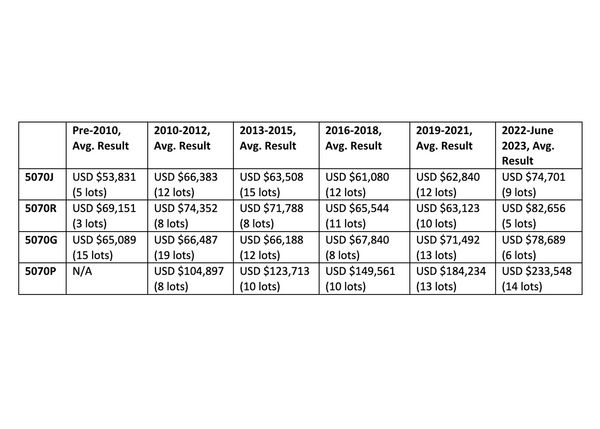
The very first 5070J to appear at auction sold for CHF 26,450 in April 2003 (approx. USD $28,428 at the time), which would have been slightly below the model’s reported original retail price. The 5070J's next appearance at auction would come in September 2005, where there was a slight improvement with a result of USD $32,300, approximately the watch’s original MSRP. The third 5070J to come to auction was in December 2007. It achieved USD $67,260 – a figure that would soon prove to be a sweet spot for the gold 5070 models.
In fact, when I converted and averaged out the results of every 5070J that has sold at a major international auction house between April 2003 and July 2023, the median figure was right in the middle of the USD $60,000 ballpark, with the 65 total sold lots holding an approximate 20-year average value of USD $64,273 each.
I took my data a step further by breaking down the average sale performance of each of the four core 5070 variants in (primarily) three-year intervals. You’ll see in the above chart that the 5070J has remained mostly inside the USD $60,000 range, with a slight outlier of at most $6,000 in either direction. And based on these intervals, the 5070J has seen its value increase by approximately 39 percent over two decades of performance in the auction market – significantly less than the pace of inflation for the American dollar in the same period.
These multi-year averages become even tighter when you review the 5070R and 5070G results. The pink-gold 5070R reveals an average 20 percent increase in value between 2007 and 2023, despite there being a 31 percent increase between the 5070R’s lowest (2019-2021) and its highest (2022-present) valuation period.
The 5070G, meanwhile, being the most common 5070 variant to appear at auction over the years, has maintained a consistent but gradual 21 percent increase in its average valuation between its first appearance at auction in 2004 until today. The platinum ref. 5070P has had a bit of a different trajectory. As the rarest and most contemporary looking of the four series-produced 5070 models, the 5070P has always attracted a higher level of interest among collectors that its three golden siblings have yet to achieve. It's seen an increase in average value at auction of more than 120 percent since its first appearance in 2010.
Conclusion
Patek Philippe spent much of the 1990s embracing its history of complications. Under the leadership of Philippe Stern, Patek Philippe began to introduce new minute-repeating wristwatches (ref. 3979, ref. 3974, and ref. 3939) for the first time in decades. A number of new perpetual calendars were soon revealed (ref. 5040, ref. 5050), as well as the impressive addition of multiple new grand complication wristwatches to the Patek Philippe catalog (ref. 5016, ref. 5004).
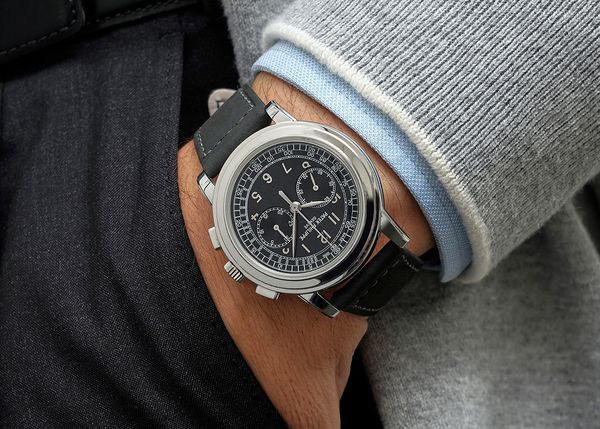
The ref. 5070 deserves to be considered in the same breadth as many of the above watches. It was not only the first independent chronograph from Patek Philippe in 30 years, but it also played a significant role in helping carry Patek Philippe into the new milennium. It's difficult to say for sure, but I believe the appreciation and understanding of the 5070 by collectors will gradually grow as time goes on.
You can learn more, place a bid, and view the entire Geneva Watch Auction: XIX catalog right here, and the Hong Kong Watch Auction: XVIII, right here.
About Phillips In Association With Bacs & Russo
The team of specialists at PHILLIPS Watches is dedicated to an uncompromised approach to quality, transparency, and client service. Phillips in Association with Bacs & Russo holds the world record for the most successful watch auction, with its Geneva Watch Auction: XIV having realized $74.5 million in 2021. Over the course of 2021 and 2022, the company sold 100% of the watches offered, a first in the industry, resulting in the highest annual total in history across all the auction houses at $227 million.
About Logan Baker
Logan has spent the past decade working in watch-focused media, reporting on every aspect of the industry. He joined Phillips in Association with Bacs & Russo at the start of 2023 as the department's Senior Editorial Manager. He splits his time between New York and Geneva.
Recommended Reading
Compact Dimensions And Complicated Watches: A Look At Patek Philippe Under Philippe Stern
